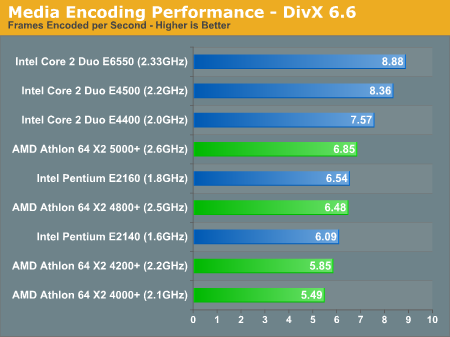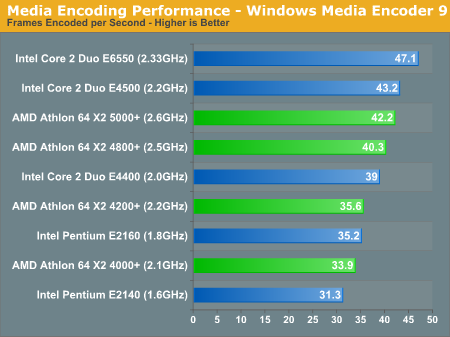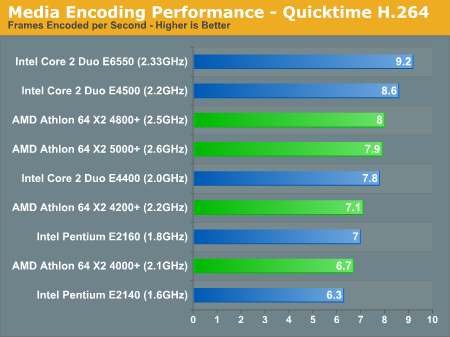Midrange CPU Roundup: It's Time to Buy
by Anand Lal Shimpi on September 28, 2007 2:00 AM EST- Posted in
- CPUs
Encoding Performance
Media encoding has finally reached the popularity it was predicted to be at years ago; the advent of portable media players and other devices that need transcoded content for proper playback has increased the role of media - in particular video - encoding on the desktop. Thankfully, even the slowest CPUs today can handle video encoding much better than they used to as little as a couple of years ago. You can thank having two cores on a single die for that.
Our DivX test uses version 6.6 of the codec alongside Xmpeg 5.0.3. We transcode an MPEG-2 file to DivX using an Unconstrained profile and a quality preset of 5. All other settings are left to their defaults and unlike our usual DivX test, enhanced multithreaded is left off since we're not dealing with any quad-core processors here.

DivX encoding performance is a clear win for Intel; the E4500 outpaces the X2 5000+ by over 20% and the E4400 is faster than its 4800+ competitor by 16%. Even the Pentium E2160 is a hair faster than the 4800+, and 19% faster than its price competitor: the 4000+. DivX performance is a particular strong point of the Core 2 architecture thanks to its significantly improved SSE engine. Worth note is that SSEn performance in general is one area where AMD's Phenom core will improve over the K8 that we're looking at now.
Windows Media Encoder has always been more evenly split between AMD and Intel, and we're seeing a perfect example of that here today. We encoded an MPEG-2 file to a WMV using the Windows Media Video Advanced Profile codec, with all settings left to their defaults.

The Core 2 Duo E4500 performs identically to the Athlon 64 X2 5000+, as do the 4800+ and E4400. The Pentium E2160 holds a slight advantage over the Athlon 64 X2 4000+ but it's nothing worth writing home about. As far as we can see, AMD and Intel offer the same price/performance in Windows Media encoding.
H.264 encoding is also becoming more popular thanks to its small file size at decent quality; for our QuickTime H.264 test we used the same source file as in the WME test and used QuickTime's default H.264 export settings.

The performance standings are pretty much identical to the WME test results, with the E4500 a bit ahead of the 5000+ but the rest of the contenders are in a close race.
MP3 Encoding is no longer the CPU hog that it once was when MP3s first burst onto the scene years ago, but at lower clock speeds ripping time can add up, especially if you're doing a lot of it. iTunes' MP3 encoder is multi-threaded and thus both cores are hard at work in this benchmark:

Intel takes the lead once more in the MP3 encoding tests. The E4500 outpaces the X2 5000+ by a significant 14% margin. Even the E4400 is faster than the 5000+, and the 4000+ is no match for Intel's Pentium E2160. Intel is a clear win here, and though we must admit that other MP3 encoders may not show the same results, iTunes' immense popularity make this an important benchmark.
Media encoding has finally reached the popularity it was predicted to be at years ago; the advent of portable media players and other devices that need transcoded content for proper playback has increased the role of media - in particular video - encoding on the desktop. Thankfully, even the slowest CPUs today can handle video encoding much better than they used to as little as a couple of years ago. You can thank having two cores on a single die for that.
Our DivX test uses version 6.6 of the codec alongside Xmpeg 5.0.3. We transcode an MPEG-2 file to DivX using an Unconstrained profile and a quality preset of 5. All other settings are left to their defaults and unlike our usual DivX test, enhanced multithreaded is left off since we're not dealing with any quad-core processors here.

DivX encoding performance is a clear win for Intel; the E4500 outpaces the X2 5000+ by over 20% and the E4400 is faster than its 4800+ competitor by 16%. Even the Pentium E2160 is a hair faster than the 4800+, and 19% faster than its price competitor: the 4000+. DivX performance is a particular strong point of the Core 2 architecture thanks to its significantly improved SSE engine. Worth note is that SSEn performance in general is one area where AMD's Phenom core will improve over the K8 that we're looking at now.
Windows Media Encoder has always been more evenly split between AMD and Intel, and we're seeing a perfect example of that here today. We encoded an MPEG-2 file to a WMV using the Windows Media Video Advanced Profile codec, with all settings left to their defaults.

The Core 2 Duo E4500 performs identically to the Athlon 64 X2 5000+, as do the 4800+ and E4400. The Pentium E2160 holds a slight advantage over the Athlon 64 X2 4000+ but it's nothing worth writing home about. As far as we can see, AMD and Intel offer the same price/performance in Windows Media encoding.
H.264 encoding is also becoming more popular thanks to its small file size at decent quality; for our QuickTime H.264 test we used the same source file as in the WME test and used QuickTime's default H.264 export settings.

The performance standings are pretty much identical to the WME test results, with the E4500 a bit ahead of the 5000+ but the rest of the contenders are in a close race.
MP3 Encoding is no longer the CPU hog that it once was when MP3s first burst onto the scene years ago, but at lower clock speeds ripping time can add up, especially if you're doing a lot of it. iTunes' MP3 encoder is multi-threaded and thus both cores are hard at work in this benchmark:

Intel takes the lead once more in the MP3 encoding tests. The E4500 outpaces the X2 5000+ by a significant 14% margin. Even the E4400 is faster than the 5000+, and the 4000+ is no match for Intel's Pentium E2160. Intel is a clear win here, and though we must admit that other MP3 encoders may not show the same results, iTunes' immense popularity make this an important benchmark.










44 Comments
View All Comments
jonp - Sunday, September 30, 2007 - link
I too wonder about the Netburst admonition. There are probably millions of Netburst CPUs out there that are happily computing away with no thought of Anandtech at all; doing their thing; producing great results for their owners. The biggest concern I have seen is thermal and that, only in relation to overclocking. Assuming there are more than a few users that don't need to or want to overclock; then there are some great bargins in used Netburst Processors and accompanying motherboards.It doesn't appear to me that "...if you know what's best for you." is either technical, professional or helpful. Maybe it was meant as a joke...sorry it's not that funny.
HotdogIT - Friday, September 28, 2007 - link
Yes, you did. Given the combination of power usage savings, pure performance benefits, and overclocking ability (since you mentioned 3.6ghz on the Pentium D, I assume we can go with at least 2.4 out of an e2140, for comparisons sake), the C2D/Pentium E line is much better.
The problem with a lot of the "lol Pentium D overclocking" articles is they fail to overclock what they're comparing against. You take a Pentium D 805 and OC it to 4ghz, sure, the performance delta over an e2140 will be big. But apply the same cooling and thought into OCing the e2140, and that delta will swing the other way.
ThatLukeGuy - Saturday, September 29, 2007 - link
So what would make the most sense to change out the Pentium D805 to that would keep me at (or better yet raise the bar of) the performance I'm getting now? An OC'd e2140 or something higher up the ladder? I'm matching this to a 2gigs ram, an nice MSI SLI plat mobo, and an 8800gts320mb. I'd want something that wouldn't bottleneck the system which is what the P.D805 did when it was stock.
HotdogIT - Sunday, September 30, 2007 - link
It's going to depend on a lot of factors. If you're gaming, a change in the CPU may very well do very little in changing any performance; especially at a higher resolution, the CPU may make NO difference.
I'd look into the e2140/e2160/e4X00 line, if you wanted to stay lower cost. At the VERY least, you'll get a boost in energy efficency: The Pentium Ds were and are power hogs, especially compared to the newer line.
What performance did you see increase when you overclocked the Pentium D? Did gaming increase? If so, then a C2D based system would be much better, regardless of an overclock; Netburst just don't handle the games as well.
If, somehow, you're running something that is AMAZINGLY well tuned for Netburst, you may see less of an increase. But these applications are rare these days, so I doubt you'd see that in most cases.
Parhelion69 - Friday, September 28, 2007 - link
Anand did you do the power consumption tests on the overclocked cpus? I think it's important to know, if you haven't, can't you at least give us a rought estimation? It'd be greatly appreciated. Thanks.dm0r - Friday, September 28, 2007 - link
Thats a great article Anand, I missed this kind of roundup.Enjoyed a lot and the only thing is missing is the performance per watt, but anyway very good article.Thanks for sharing!eetnoyer - Friday, September 28, 2007 - link
Why not throw in the 4200+? I know it's 90nm, but I just got one for $74, and (for me)it looks like the sweet spot of price/performance for AMD. And, given how well tuned their 90nm process is at EOL, I wouldn't be surprised to see power consumption close to that of the 65nm chips. If you want, you could use the 65W version (it's only a buck more).Uter - Friday, September 28, 2007 - link
Anand, is the BE-2400 still coming out? Or, when you say that there are two Athlon X2 BE Processors, the BE-2350 and BE-2300, is that a subtle hint that we shouldn't expect to see it? I just want to make sure I pick one of these up while there are still available...bogda - Friday, September 28, 2007 - link
Oveclocking results are not fair. You chose horrible motherboards for AMD overclocking.For example, Biostar AMD motherboards cost 50-60 euros. They are much better overclockers than MSI or ASUS you chose. My Athlon BE-2300 easily overclocks from default 1,9GHz to over 2,8GHz with stock HSF.
wdb1966 - Sunday, September 30, 2007 - link
I completely agree, the boards chosen for the AMD chips are horrible.Gigabyte's MA69GM-S2H and Abit's NF-M2 nView would have been far superior choices in every way...poor motherboard choices, very poor.